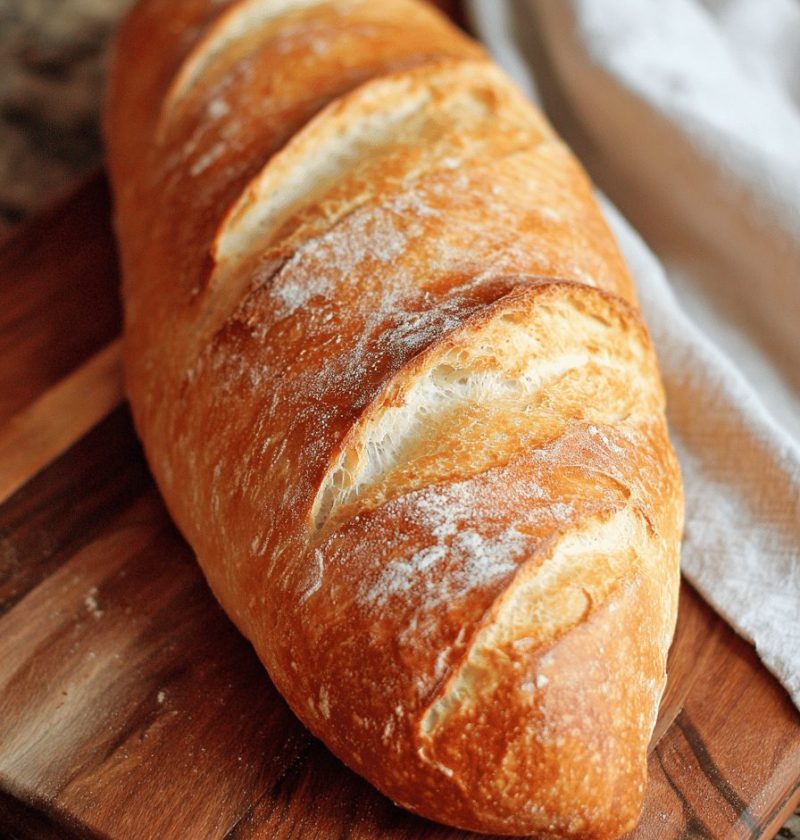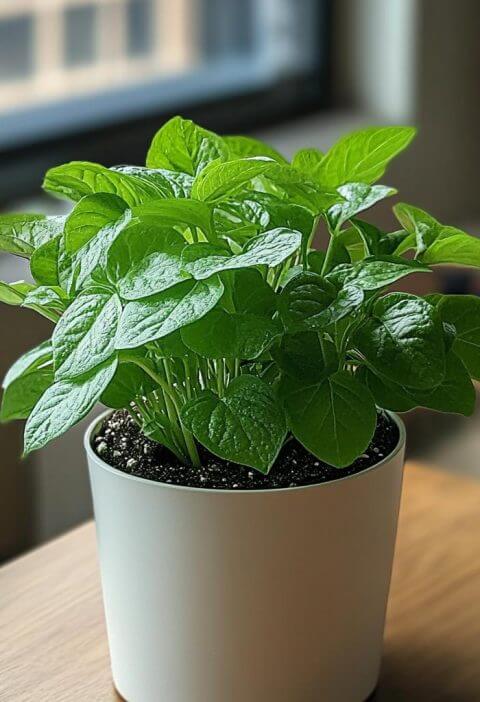Would you like to save this?
French Bread Recipe: Classic Crusty Artisan Baguette You Can Bake at Home
This French Bread Recipe delivers a golden, crusty exterior and pillowy interior with simple pantry staples—no starter needed, and it’s truly easy to follow.
Let me explain why this homemade French bread stands out. It’s a traditional-style baguette born from my decades of baking—and yes, at 50 I still relish the aroma that wafts through my kitchen every Saturday morning. Inspired by childhood visits to our local bakery, I set out to craft a loaf that’s both authentic and approachable. With just flour, water, yeast, and salt, you’ll taste real artisan magic—perfect as a meal side, a hearty sandwich base, or simply torn apart with a schmear of butter.
Why You’ll Love This Recipe
- Simple ingredients you likely have on hand—no fancy starters or mixers
- Crispy, crackling crust meets soft, airy dough
- Gentle on your schedule: minimal hands-on time
- Perfect for soup nights, picnic snacks, or holiday spreads
- Kid-friendly project—let them shape the dough!
- Budget-wise baking: homemade artisan loaf for pennies
- Impressive enough for guests, comforting enough for family dinners
Ingredients
• 4 cups (500 g) bread flour or King Arthur all-purpose flour (for a lighter crumb, swap half with whole wheat)
• 1½ cups (360 ml) warm water (about 110°F—use a digital thermometer)
• 2 teaspoons instant yeast (or active dry yeast; see Notes)
• 2 teaspoons fine sea salt (Kosher salt works too)
• 1 teaspoon sugar (optional—feeds the yeast for a more vigorous rise)
• 1 tablespoon olive oil (optional—yields a slightly softer crust)
Tip: Weigh your flour for consistency (1 cup ≈ 125 g). If you’re in a humid climate, you might need a touch more flour to keep the dough from feeling too sticky.
Directions
- Mix dry ingredients. In a large bowl, whisk together flour, yeast, salt, and sugar. Stir briskly so the salt and yeast stay apart—salt can slow down yeast if it contacts it directly.
- Add water and oil. Pour warm water and olive oil into the flour mix. Use a wooden spoon or your hand to combine until a shaggy dough forms.
- Knead to strengthen. Turn dough onto a lightly floured surface and knead for 8–10 minutes—press, fold, and turn. You’ll know it’s ready when the dough feels smooth and springs back when poked.
- First rise. Place dough in a lightly oiled bowl, cover with plastic wrap or a damp towel, and let rest in a warm spot for about 1 hour (it should double).
- Shape into baguettes. Gently deflate the dough, divide it into two equal pieces, and roll each into an 18-inch baguette shape—think long cylinder with tapered ends.
- Final proof. Line a baking sheet with parchment or a Silpat. Lay loaves on the sheet, cover lightly, and let them puff for 30–40 minutes. They’ll look slightly pillowy but still firm enough to handle.
- Score and bake. Preheat oven to 450°F with a baking stone or upside-down sheet on the rack. Just before baking, use a sharp lame or serrated knife to make 3–4 diagonal cuts on each loaf. Slide them onto the hot surface, toss a cup of hot water into a rimmed pan on the lower rack for steam, and bake 20–25 minutes until deeply golden.
- Cool fully. Transfer loaves to a wire rack and let rest at least 30 minutes—this step sets the crumb and prevents gummy slices.
Servings & Timing
Makes 2 medium baguettes
Prep Time: 15 minutes hands-on
First Rise: 1 hour
Shaping & Proofing: 40 minutes
Baking: 25 minutes
Total Time: About 2 hours
Variations
• Rosemary & Sea Salt: Gently press fresh rosemary leaves and a sprinkle of coarse salt onto the unbaked loaves.
• Sesame Crunch: Brush loaves with water and roll in toasted sesame seeds.
• Whole Wheat Twist: Swap half the bread flour for whole wheat for a nutty flavor.
• Garlic-Butter Swirl: Gently press thin garlic-infused butter ribbons into the dough before the final proof.
• Olive & Herb: Fold chopped olives and thyme into the dough at the end of kneading.
• Seeded Topper: Mix poppy, flax, and sunflower seeds for a crunchy crust.
Storage & Reheating
Store at room temperature in a paper bag for 1–2 days—avoid plastic to keep the crust crisp.
Freeze cooled loaves in airtight bags for up to 3 months; thaw at room temperature for 2–3 hours.
Reheat slices or whole loaves at 350°F for 10–12 minutes, loosely wrapped in foil to revive that fresh-baked feel.
Tip: For day-old bread, toast thick slices and rub with a cut garlic clove—brings back life and adds flavor.
Notes
• Yeast choice: If using active dry yeast, bloom it in the warm water for 5–7 minutes before mixing.
• Humidity & flour: On rainy days, flour can absorb moisture from the air—tweak by adding a tablespoon at a time until dough consistency feels right.
• Scoring tips: Hold the blade at a 30° angle for thin, elegant cuts. Straight down scoring yields a rustic look, angled cuts let the dough “ear” pop up.
• Steam hack: A cast-iron skillet works wonders for oven steam—just preheat it and pour water in when the loaves go in.
• Altitude note: Above 5,000 feet, reduce yeast by ¼ teaspoon and extend rising times.
FAQs
Q: Can I use all-purpose flour instead of bread flour?
A: Absolutely—bread flour gives more chew, but all-purpose works fine; just watch hydration since AP often absorbs less water.
Q: Why is my crust not crispy?
A: You might need more steam or a hotter oven; try a baking stone and toss in hot water for better steam.
Q: My dough is super sticky—help!
A: Add flour a tablespoon at a time while kneading, but avoid over-flouring or you’ll get a tough crumb.
Q: Can I skip resting after baking?
A: It’s tempting, but cooling for at least 30 minutes prevents a gummy center and sets the crumb structure.
Q: Why didn’t my dough rise?
A: Check your yeast’s freshness (it should bubble in warm water) and ensure your proofing spot isn’t too cool.
Q: Can I make dough ahead and refrigerate?
A: Yes—after the first rise, cover and chill for up to 24 hours; bring back to room temp before shaping.
Q: How do I store leftover slices?
A: Layer parchment between slices in an airtight container to prevent sticking, then freeze or keep at room temp for a day.
Q: What’s the secret to air pockets?
A: Gentle handling during shaping and a high-hydration dough encourage irregular holes—embrace them for that artisan look!
Conclusion
This French Bread Recipe brings together the joy of traditional baking with the comfort of homemade goodness—crispy crust, tender crumb, and that aroma that makes every meal feel special. Give it a try this weekend, and don’t forget to share your first slice (or your favorite variation) in the comments below. Hungry for more? Check out my Easy Sourdough Starter or Homemade Focaccia posts next!

French Bread Recipe: Classic Crusty Artisan Baguette You Can Bake at Home
Instructions
- In a large bowl, whisk together flour, yeast, salt, and sugar. Stir briskly so the salt and yeast stay apart—salt can slow down yeast if it contacts it directly.
- Pour warm water and olive oil into the flour mix. Use a wooden spoon or your hand to combine until a shaggy dough forms.
- Turn dough onto a lightly floured surface and knead for 8–10 minutes—press, fold, and turn. You’ll know it’s ready when the dough feels smooth and springs back when poked.
- Place dough in a lightly oiled bowl, cover with plastic wrap or a damp towel, and let rest in a warm spot for about 1 hour (it should double).
- Gently deflate the dough, divide it into two equal pieces, and roll each into an 18-inch baguette shape—think long cylinder with tapered ends.
- Line a baking sheet with parchment or a Silpat. Lay loaves on the sheet, cover lightly, and let them puff for 30–40 minutes. They’ll look slightly pillowy but still firm enough to handle.
- Preheat oven to 450°F with a baking stone or upside-down sheet on the rack. Just before baking, use a sharp lame or serrated knife to make 3–4 diagonal cuts on each loaf. Slide them onto the hot surface, toss a cup of hot water into a rimmed pan on the lower rack for steam, and bake 20–25 minutes until deeply golden.
- Transfer loaves to a wire rack and let rest at least 30 minutes—this step sets the crumb and prevents gummy slices.







